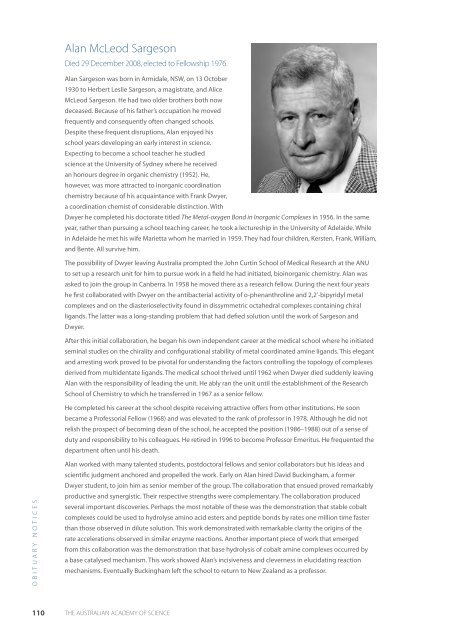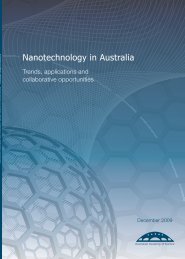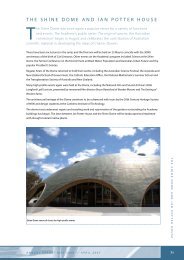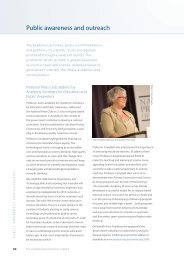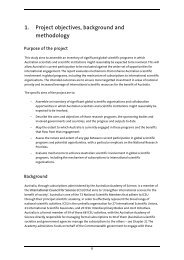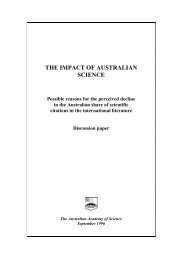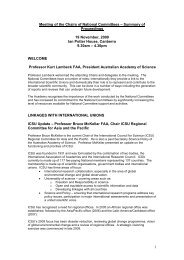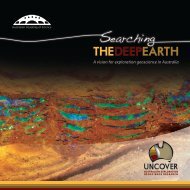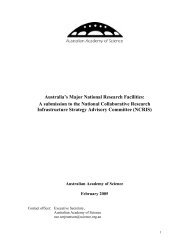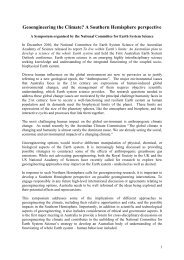ANNUAL REPORT - Australian Academy of Science
ANNUAL REPORT - Australian Academy of Science
ANNUAL REPORT - Australian Academy of Science
Create successful ePaper yourself
Turn your PDF publications into a flip-book with our unique Google optimized e-Paper software.
Alan McLeod Sargeson<br />
Died 29 December 2008, elected to Fellowship 1976.<br />
Alan Sargeson was born in Armidale, NSW, on 13 October<br />
1930 to Herbert Leslie Sargeson, a magistrate, and Alice<br />
McLeod Sargeson. He had two older brothers both now<br />
deceased. Because <strong>of</strong> his father’s occupation he moved<br />
frequently and consequently <strong>of</strong>ten changed schools.<br />
Despite these frequent disruptions, Alan enjoyed his<br />
school years developing an early interest in science.<br />
Expecting to become a school teacher he studied<br />
science at the University <strong>of</strong> Sydney where he received<br />
an honours degree in organic chemistry (1952). He,<br />
however, was more attracted to inorganic coordination<br />
chemistry because <strong>of</strong> his acquaintance with Frank Dwyer,<br />
a coordination chemist <strong>of</strong> considerable distinction. With<br />
Dwyer he completed his doctorate titled The Metal-oxygen Bond in Inorganic Complexes in 1956. In the same<br />
year, rather than pursuing a school teaching career, he took a lectureship in the University <strong>of</strong> Adelaide. While<br />
in Adelaide he met his wife Marietta whom he married in 1959. They had four children, Kersten, Frank, William,<br />
and Bente. All survive him.<br />
The possibility <strong>of</strong> Dwyer leaving Australia prompted the John Curtin School <strong>of</strong> Medical Research at the ANU<br />
to set up a research unit for him to pursue work in a field he had initiated, bioinorganic chemistry. Alan was<br />
asked to join the group in Canberra. In 1958 he moved there as a research fellow. During the next four years<br />
he first collaborated with Dwyer on the antibacterial activity <strong>of</strong> o-phenanthroline and 2,2’-bipyridyl metal<br />
complexes and on the diasterioselectivity found in dissymmetric octahedral complexes containing chiral<br />
ligands. The latter was a long-standing problem that had defied solution until the work <strong>of</strong> Sargeson and<br />
Dwyer.<br />
After this initial collaboration, he began his own independent career at the medical school where he initiated<br />
seminal studies on the chirality and configurational stability <strong>of</strong> metal coordinated amine ligands. This elegant<br />
and arresting work proved to be pivotal for understanding the factors controlling the topology <strong>of</strong> complexes<br />
derived from multidentate ligands. The medical school thrived until 1962 when Dwyer died suddenly leaving<br />
Alan with the responsibility <strong>of</strong> leading the unit. He ably ran the unit until the establishment <strong>of</strong> the Research<br />
School <strong>of</strong> Chemistry to which he transferred in 1967 as a senior fellow.<br />
He completed his career at the school despite receiving attractive <strong>of</strong>fers from other institutions. He soon<br />
became a Pr<strong>of</strong>essorial Fellow (1968) and was elevated to the rank <strong>of</strong> pr<strong>of</strong>essor in 1978. Although he did not<br />
relish the prospect <strong>of</strong> becoming dean <strong>of</strong> the school, he accepted the position (1986–1988) out <strong>of</strong> a sense <strong>of</strong><br />
duty and responsibility to his colleagues. He retired in 1996 to become Pr<strong>of</strong>essor Emeritus. He frequented the<br />
department <strong>of</strong>ten until his death.<br />
OBITUARY NOTICES<br />
Alan worked with many talented students, postdoctoral fellows and senior collaborators but his ideas and<br />
scientific judgment anchored and propelled the work. Early on Alan hired David Buckingham, a former<br />
Dwyer student, to join him as senior member <strong>of</strong> the group. The collaboration that ensued proved remarkably<br />
productive and synergistic. Their respective strengths were complementary. The collaboration produced<br />
several important discoveries. Perhaps the most notable <strong>of</strong> these was the demonstration that stable cobalt<br />
complexes could be used to hydrolyse amino acid esters and peptide bonds by rates one million time faster<br />
than those observed in dilute solution. This work demonstrated with remarkable clarity the origins <strong>of</strong> the<br />
rate accelerations observed in similar enzyme reactions. Another important piece <strong>of</strong> work that emerged<br />
from this collaboration was the demonstration that base hydrolysis <strong>of</strong> cobalt amine complexes occurred by<br />
a base catalysed mechanism. This work showed Alan’s incisiveness and cleverness in elucidating reaction<br />
mechanisms. Eventually Buckingham left the school to return to New Zealand as a pr<strong>of</strong>essor.<br />
110<br />
THE AUSTRALIAN ACADEMY OF SCIENCE


